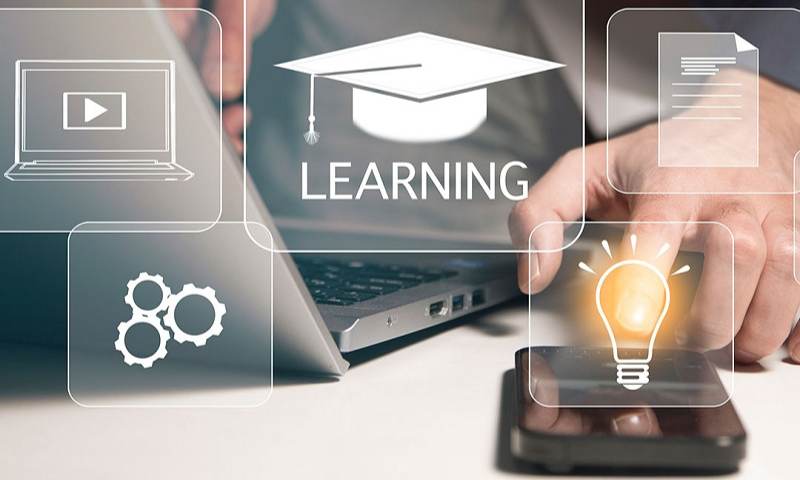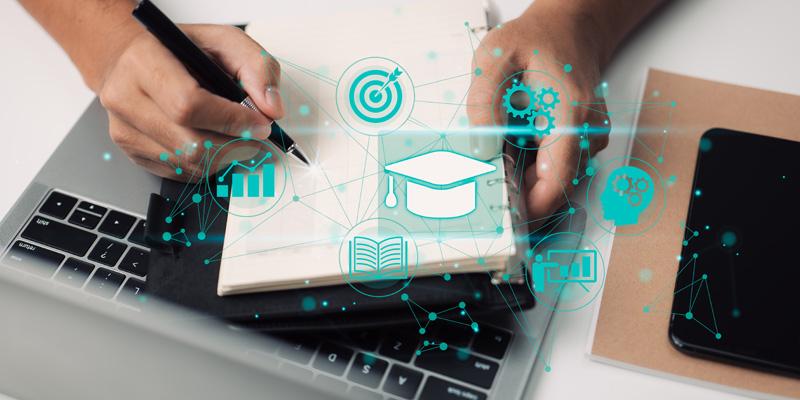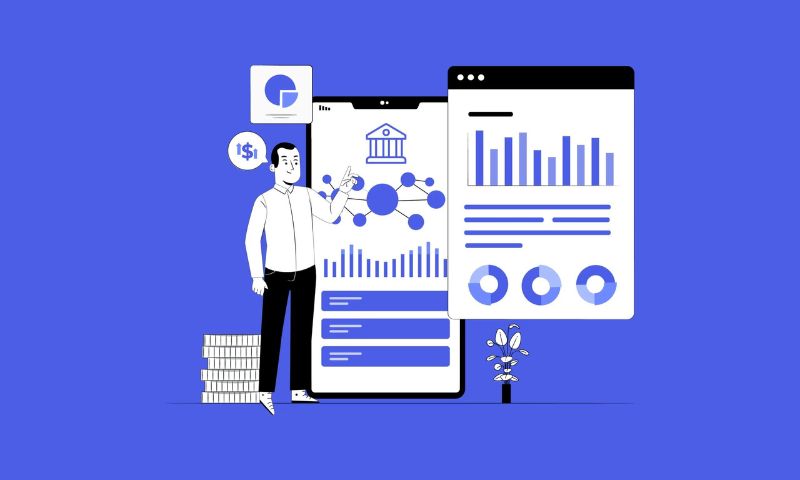If you’ve ever questioned how do decentralized learning platforms with blockchain work?, you’re not alone. In a world where tech and education collide, the rise of such platforms is reshaping the very fabric of learning. We are punching through the old paper-ledger days and stepping into an era where your academic wins are carved in digital stone. Blockchain isn’t just for crypto fans anymore; it has hitched a ride with education, and together, they’re about to start a revolution. Think secure, think smart contracts guiding your course from start to finish. This isn’t the future—it’s here, and it’s time you got the lowdown on how it’s weaving into your learning journey.
The Foundation of Blockchain in Education
Exploring Distributed Ledger Technology in Academia
Imagine a huge digital book with many copies. This book is open for all to see. This is always up to date. That’s what we call a distributed ledger. It’s a base of blockchain in education. It keeps all data safe and sound. Each page tells who did what in school. This can’t be changed by anyone. So it’s honest and clear for all.
This tech is fresh air for schools. It can track who learned what skills. And guess who holds the pen? It’s not just teachers or big schools. It’s everyone learning. Yes, you too! We join hands around the globe. We build peer-to-peer learning networks. It helps all to share and grow together. What we once dreamed, blockchain makes real. Each person can now hold their learning proof. And it’s respected anywhere they go.
The Role of Smart Contracts in Course Delivery
Smart contracts sound fancy. But they’re not. They’re like vending machines. If you meet the rules, you get the prize. Here, the prize is learning new things. You do your part, the contract does its part. It’s fair and square.
I design recipes. Not for food but for classes. They’re smart contract recipes for courses. You take a time-out from school? No sweat. Jump back in when ready. Your progress stays put. We got your back.
The class rules live on the blockchain. Your work clicks in like Lego pieces. You do your task, and zap! You get your badge or coin. Your work and rewards stay yours. True story. This gives power to learners. It’s all about trust in what you do.
So there it is. Blockchain sticks your learning together. Like Lego, remember? It turns many into one. One strong, fair, and open way to learn. You work hard, you earn your credit. Every high-five you get stays yours for good. Forever.
A school that’s open all the time, for everyone? That’s the future. And it’s just the start. We’re building more than just classrooms here. We’re building trust, and it’s solid as a rock. We’re in this together, and the journey rolls on.
Empowering Learners with Decentralized Platforms
Self-Sovereign Identity and Student-Driven Experiences
Imagine a classroom where you hold the keys. I mean, really hold them. That’s what a self-sovereign identity does for you. In education, think of it like a backpack you pack yourself. You decide what goes in and stays out. This means your school records and projects are yours and yours alone.
Wondering how that works? Well, think about blockchain as a super-secure, online chain of blocks. Each block holds info, like your courses, grades, and projects—all locked up tight. Only you have the key to unlock your blocks, showing what you learned. And remember, it’s not just one classroom. It’s learning from around the world, at your fingertips.
Token Economy and Incentivizing Educational Progress
Now, let’s talk rewards. Who doesn’t like a gold star? But what if those stars were tokens you could use, like money or points? This is where the token economy sparkle shines. In classes on the blockchain, you earn tokens for finishing work and acing tests. It’s like getting arcade tickets, but for learning.
These aren’t just any tokens. You can trade them for more classes or even cash them out. Teachers love it because when you win, they win. Schools get happy when they see students eager to earn and learn. This is using money smarts in school. Every quiz aced means more tokens jingling in your pocket. It’s fun, it keeps you going, and it makes learning a win-win game.
Harnessing these new tools in education is like planting seeds in a fresh garden. Self-sovereign identity gives you control, while tokens make hitting the books as exciting as hitting the arcade. It means better learning for all, one block at a time.
Verifying Achievements with Immutable Records
Digital Certificates on Blockchain for Lifelong Learning
Picture getting a gold star in school that lasts forever. Blockchain does just that. It’s like a digital box that keeps all your gold stars safe. No one can take them or change them. These stars are your skills and wins that you gather over time. They stay with you as you grow up. You can show them to anyone, anywhere, to prove what you can do. No doubts, no tricks, just real proof.
Decentralized Applications (DApps) for Credible Credentialing
Now, let’s dive deep. Imagine a school that’s not a building, but lives on computers all over. This school doesn’t have just one boss. Everyone who joins helps run it. Here, when you do a task or pass a test, you get a special note, a bit like that gold star we talked about. But this note is fancy. It’s made with smart tech called blockchain. It’s yours, it’s safe, and it’s trusted. Even if the school vanishes, your note won’t. It’s always with you. People call these schools DApps, short for decentralized applications. Through these, we make sure our learning stands tall and proud for all to see.
Blockchain in education is like having a super-strong backpack that holds all the stuff you learn. This backpack never breaks, and it shows everyone what you’ve got inside. Peer-to-peer learning networks make sharing notes with friends easy as pie. Just like trading cards, but for your brain gains. And the best part? No one can peek inside or take your cards away.
Smart contracts for courses mean when you promise to take a class, the tech seals the deal. You do the work, and like magic, you get your gold star — no waiting, no mix-ups. Sometimes you can even earn tokens, like arcade tickets, for your hard work. That’s token economy in education. You can trade these for more classes or cool stuff.
This all is a big win for people learning stuff at their pace. It’s real fair, and it’s all because of a new way of thinking called decentralization in eLearning. No more middle folks holding all the cards; you’re in control.
Having these powerful tools means better security in online learning. No one can mess with your hard work. And for those who teach, it’s a dream come true. They can see your gold stars and trust them. Plus, with open-source learning platforms, anyone can help make the school better. We’re all pitching in.
In the end, blockchain gives you power over your wins and smarts. It lets everyone, kids and grown-ups, hold on to their gold stars forever. That’s the beauty of blockchain for skill tracking and lifelong learning records. Now that’s a smart way to learn and prove your smarts, right?
Enhancing eLearning Through Security and Interoperability
Blockchain-Encrypted Data in Online Learning Environments
Imagine keeping your school papers safe as gold in a bank vault. That’s how secure blockchain makes your online learning stuff. Each piece of info is like a locked box, tied to a chain with others. No one can change any box without others knowing. That’s what we call “blockchain-encrypted data”.
Let’s crack that open. When you learn online, you want your hard work to stay yours. Here comes blockchain. It locks down your info. So, when you do a quiz or write an essay, blockchain keeps it snug and sound. This means you can prove it’s truly yours and not anyone else’s work. No tricks, no mix-ups.
Now, think of those gold bars in the vault. In blockchain tech, each gold bar is a piece of data – your quiz score, your uploaded homework, or your art project. All of these bars – data – link together in a chain. That’s your learning record, and only you have the key. With that key, you can show your teacher, a college, or a new boss what you’ve done.
This is super good for schools too. They can see who did what without a sweat. They know Joey did his math, and Emma finished her science fair project. Because with blockchain, what you see is what you get. No lies, no tricks. It’s all open, honest stuff.
The Emergence of Decentralized Autonomous Organizations in Education (DAOs)
Now, let’s take a little walk into the future – a place where schools run on the power of everyone, not just the big bosses. This future place is what we call “Decentralized Autonomous Organizations” or DAOs for short.
DAOs are like a class where every kid has a say, not just the one with the loudest voice. In education, that means all students and teachers get to make choices together. They vote on new courses, how to spend money, and what the class rules are. And guess what? Blockchain makes this all flow smooth.
In a DAO, each vote is a token – a small piece of the power pie. Teachers and learners earn these tokens. They help make the class great. The more you learn and pitch in, the more slices of pie you get. It’s as if your voice grows louder the more you take part.
Here’s the cool part: with blockchain, every vote is counted fair and square. No lost papers, no wrong tallies. And all that stuff gets locked onto the blockchain, keeping a perfect record of who said what.
So, what’s the big deal? Well, this means no one’s left out, and no one can boss everyone else around. It’s a fair game. It’s like every person holds a piece of the class in their hands, and together, they make it what they want. This is power to the learners, real democracy in learning, and boy, it’s a bright future for all of us.
In the end, blockchain isn’t just some tech buzzword. It’s the key to a door that opens up to a new world of learning. A world where your work is safe, you get a say, and everyone plays fair. And that’s something worth learning about, don’t you think?
We dove deep into blockchain’s role in education. We explored how tech shapes learning, from secure ledger use in schools to smart contracts for courses. Then we saw how blockchain gives students power, through owning their data to earning tokens for hard work. We also looked at how blockchain keeps learning proofs safe and forever. At last, we learned how it secures online study spaces and lets education groups work together better.
In closing, think of blockchain as a strong tool for the future of learning. It’s not just tech talk; it’s real change for teachers and learners. This is just the start, and the future looks bright. Keep an eye on blockchain; it’s changing education right now. Trust that I know what I’m saying – blockchain in education is a game-changer!
Q&A :
How do blockchain-based decentralized learning platforms operate?
Decentralized learning platforms utilizing blockchain technology function by creating a distributed and immutable ledger that records all educational transactions and interactions. This includes enrollment, course progress, assessments, and certification. Because blockchain ensures data integrity and security, these platforms enable a transparent and verifiable system where learners control their data and accomplishments.
What are the benefits of using blockchain for decentralized education?
The integration of blockchain into decentralized education platforms brings several advantages, such as enhanced security due to cryptography, improved transparency and traceability of records, and elimination of intermediaries, reducing potential biases and costs. It also provides learners with the power to own and share their educational credentials easily and without central authority, fostering a more accessible and inclusive educational ecosystem.
How does blockchain technology enhance learner verification and credentialing in decentralized platforms?
Blockchain enhances learner verification and credentialing by creating a tamper-proof and permanent record of all educational achievements on a decentralized network. Each credential or certificate is time-stamped and cryptographically signed, ensuring its authenticity. These verifiable credentials can be shared with employers or educational institutions, removing the need for a central verifying authority and streamlining the validation process.
Can decentralized learning platforms with blockchain increase accessibility to education?
Yes, decentralized learning platforms can significantly increase accessibility to education. They eliminate geographical and financial barriers by allowing remote access to courses and materials. The blockchain component enables cost-effective infrastructure, microtransactions for course payments, and secure record-keeping, opening doors for individuals who may not have easy access to traditional education systems.
What challenges do decentralized learning platforms with blockchain face?
While promising, these platforms face challenges, including the digital divide, as not everyone has access to the necessary technology. Also, scalability can be an issue as blockchain networks can sometimes struggle with a high volume of transactions. Adoption by the educational community and regulatory compliance in different regions can also pose hurdles that need to be carefully navigated as the technology continues to evolve.


